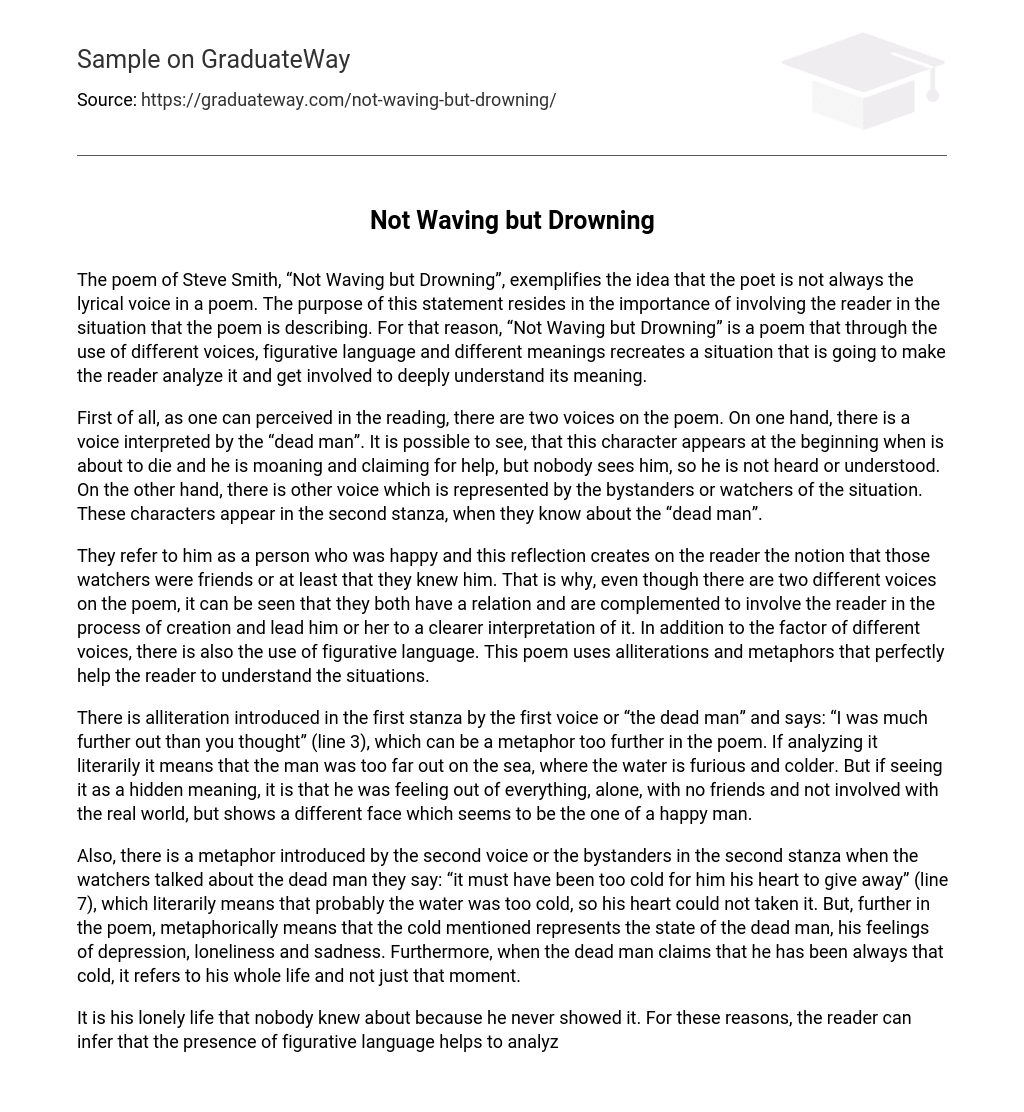The poem “Not Waving but Drowning” by Steve Smith showcases the notion that the poet is not consistently the lyrical voice in a poem. This statement emphasizes the significance of engaging the reader in the depicted situation within the poem. Consequently, “Not Waving but Drowning” utilizes various voices, figurative language, and multiple interpretations to reconstruct a scenario that compels the reader to analyze and fully comprehend its significance.
In the reading, it can be observed that there are two voices in the poem. Firstly, there is a voice portrayed by the “dead man”, who is seen at the start moaning and asking for assistance, but goes unnoticed and is not comprehended. Secondly, there is another voice embodied by the bystanders or watchers of the scene. These characters emerge in the second stanza when they become aware of the “dead man”.
They describe him as a content individual, and this portrayal gives the reader the impression that those observers were acquaintances or possibly acquainted with him. Thus, although there are two distinct voices in the poem, it is evident that both are interconnected and contribute to engaging the reader in the creative process and guiding them towards a more precise interpretation. Furthermore, aside from the presence of diverse voices, figurative language also plays a role. The poem employs alliteration and metaphors skillfully, aiding the reader in comprehending the various scenarios.
The first stanza introduces alliteration through the first voice, also referred to as “the dead man”. The voice states, “I was much further out than you thought”, which can also be interpreted metaphorically later in the poem. In a literal sense, it implies that the man was physically far out at sea in turbulent and cold waters. However, when viewed symbolically, it suggests that he felt disconnected from everything, alone, without friends, and detached from reality, despite appearing outwardly content.
The second voice or the bystanders introduce a metaphor in the second stanza, discussing the dead man. They state, “it must have been too cold for him his heart to give away”, which implies that the water was possibly too cold causing his heart to stop. However, as the poem progresses, this metaphor symbolizes the cold as the dead man’s state of being – encompassing feelings of depression, loneliness, and sadness. Additionally, when the dead man asserts that he has always been that cold, it refers to his entire life rather than just that specific moment.
Despite never showing it, the reader can infer that the presence of figurative language in the poem helps analyze its true meaning and better understand it. By appreciating these two facts, different interpretations of the poem can be made, allowing the reader to become part of its creation.
The reader’s understanding of a poem can be mislead if they think that only the poet’s voice is present. To truly grasp the situation and intention of a poem, a close reading is necessary. For example, a poem may appear to be about a man drowning and expressing the strength and coldness of the water before his death. However, with a deeper analysis, it reveals itself as a dialogue where the man tries to explain the true cause of his demise and how he was misunderstood by others.
Therefore, understanding a poem involves interpreting its various elements and actively engaging with it. It is incorrect to assume that the poet is the sole voice in a poem. By examining factors such as the voice, figurative language, and interpretations, this poem demonstrates that incorporating different voices creates a sense of involvement for the reader.
Furthermore, the utilization of metaphors and alliterations engages the reader and enhances their presence throughout the poem. Ultimately, the amalgamation of these techniques offers multiple interpretations and meanings for the reader to select. Stevie Smith’s poem serves as a prominent demonstration that prioritizing the reader’s role in crafting a poem is a remarkable approach to create a piece that will be appreciated by a wide audience.





